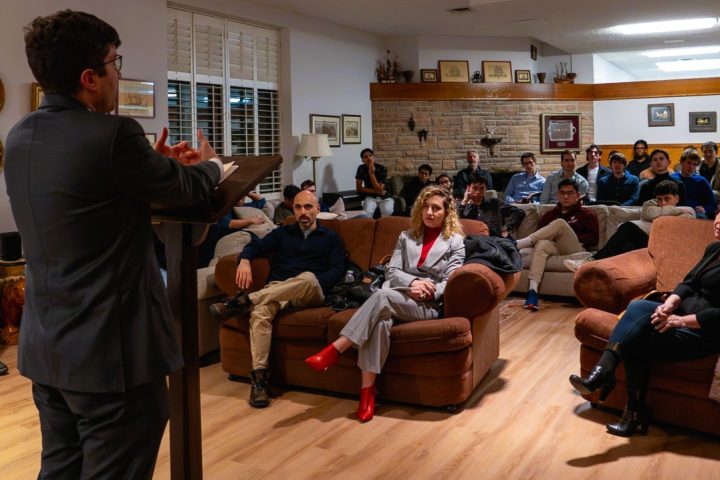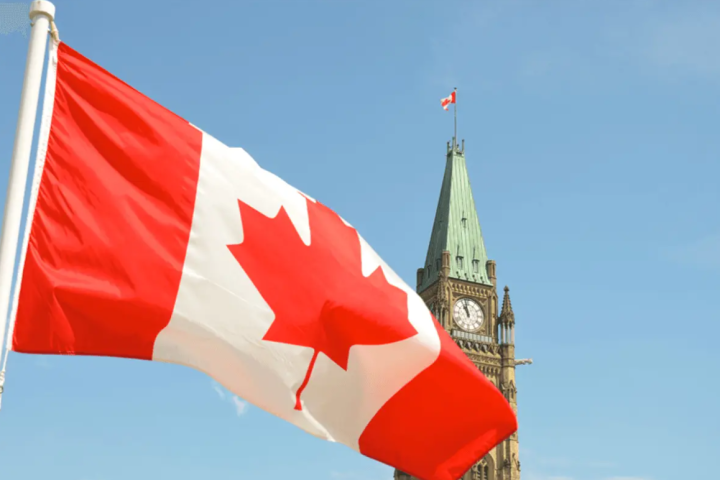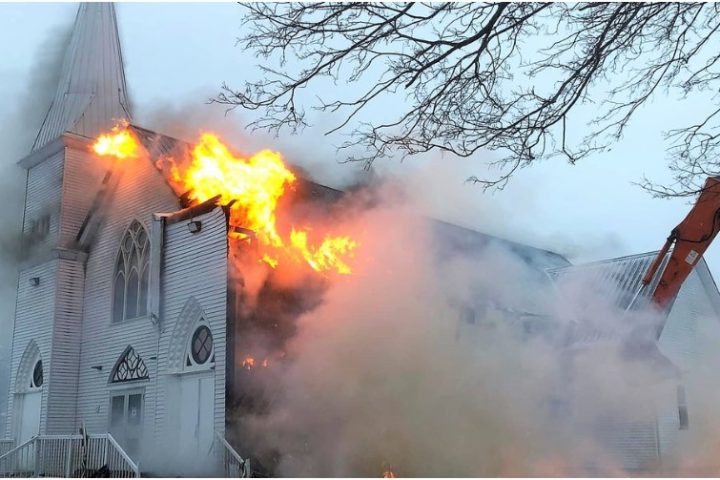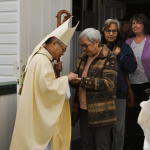By Kiply Lukan Yaworski
A former National Chief of the Assembly of First Nations and a former President of the Canadian Conference of Catholic Bishops spoke together in Saskatoon April 18, reflecting on their part in the history of Truth and Reconciliation in Canada, as well as their personal journey in becoming adopted brothers.
Former National Chief Phil Fontaine and Archbishop Emeritus James Weisgerber were the special guests at the diocesan adult faith Encounter event “Continuing the Walk” held at the Cathedral of the Holy Family in Saskatoon, which began with a land acknowledgement by MC Myron Rogal of the diocesan Office of Justice and Peace, and prayer led by Elder Diane Anderson of Our Lady of Guadalupe Indigenous Catholic Parish in Saskatoon.
As an Indigenous leader and a Residential School Survivor, Fontaine had a key role in raising public awareness about Indian Residential Schools and in working for federal and papal apologies for the harm caused to children, families and communities. As a Catholic leader, Weisgerber has grown in awareness of — and advocated for — Truth and Reconciliation, and has assisted in building greater understanding and closer relationships between the Church and Indigenous peoples.
As the then-president of the CCCB, Weisgerber invited Fontaine to address the Catholic bishops of Canada at their plenary assembly in 2008, and the following year, both men were part of a delegation of Residential School survivors and Church representatives who were received at the Vatican by Pope Benedict XVI.
And during an ancient Anishinabe adoption ceremony in 2012 in Winnipeg, Weisgerber was welcomed as a brother by community leaders Phil Fontaine, Tobasonakwut Kinew, Fred Kelly, and Bert Fontaine.
In welcoming the two visiting leaders to Saskatoon, Bishop Mark Hagemoen said that their example and initiatives have inspired many over the years, and have helped to launch a new era of reconciliation and healing. “We have come a long way, and we have a long way still to go,” Hagemoen said.

Elder Diane Anderson of Our Lady of Guadalupe Indigenous Catholic Parish in Saskatoon, and a team of local leaders led the opening prayer for the adult faith Encounter event. (Photo by Kiply Lukan Yaworski, Catholic Saskatoon News)
Weisgerber presentation
Just how far Canadian society and the Church have come in their understanding of the history of Indigenous Peoples and of the damage caused by Residential Schools was evident in Weisgerber’s summary of his own journey, which he likened to following a “GPS” that was constantly “re-calculating.”
Born in Vibank, SK, in 1938, within 30 miles of two First Nations reservations, Weisgerber described how he never saw an Indigenous person growing up “because until the 60s and 70s they were not permitted to leave the reserve without the permission of the Indian Agent.”
Later, as Indigenous People were permitted to move and to leave the reserve, the only thing about Indigenous People in the news was trouble caused by young fellows, “and it annoyed us.”
Weisgerber recalled a wedding that he officiated at as a priest in the Archdiocese of Regina, when four of the groomsmen got on their motorcycles and went to north central Regina in the wee hours of the morning and got into a brawl in which a young Indigenous man was killed. “And our reaction was: ‘what is that guy doing out in the street at four in the morning?’ and not ever asking what are these other four guys doing at four in the morning — it was very, very, very racist.”
Later on, while serving as the pastor on a First Nation in the archdiocese of Regina, he became good friends with one particular family, and one day, again at a wedding, waiting for the arrival of the bride and groom, he heard something jarring. “We were at the church sitting on the front step, waiting for them to arrive and we were chewing grass, and talking about all kinds of things, and then he said to me,’ you know, we had another brother.’ And I said, ‘oh yeah?’ And he said ‘yeah, he was killed in a brawl in Regina.’ And it still chokes me up. Because I was totally unprepared for this. I had seen that (incident) with one point of view, and now I was in new circumstances, with a new set of friends, and I saw that whole incident from another point of view. And it was really, really mind-shaking.”
In July 1990, Weisgerber began to serve on the staff of the CCCB as General Secretary. “I had hardly warmed the chair when about two months later, Phil Fontaine made his public announcement that he had been abused at Fort Alexander Residential School — the National Chief — and all hell broke loose,” said Weisgerber.
“The media went on a rampage, and we were absolutely horrified, because the leadership of the church had these ideas about residential schools, that they were wonderful places, they were doing a good job. We had no idea what was going on.”
At a gathering held in Saskatoon at the time, a gathering of a number of the Catholic bishops involved in Residential Schools “could not even agree to acknowledge that there was something wrong in that situation,” Weisgerber recalled. “That’s where we were at that time. The Oblates a year later made a public apology at Ste-Anne-du-Lac, but the rest of us couldn’t.”
However, things were moving, changing, and steadily improving, he said. “This is the way that the grace of God works, slowly, progressively.”
Weisgerber was appointed Archbishop of Winnipeg about the time of the Residential School Settlement, which paid compensation to those who attended the schools, with the government responsible for the “lion’s share,” but the churches involved in running the schools for the government also obliged to provide compensation.
Weisgerber noted that all of this raised the question of “who is the Catholic Church in Canada?” The Catholic groups or entities that operated Residential Schools were identified as parties to the agreement, contributing $29 million up front and $25 million as in-kind services. However, a $25 million “best efforts” campaign directed to Canadian Catholics failed. “We tried to raise the money, but hearts had not changed,” said Weisgerber, who along with Fontaine co-chaired that campaign, held in dioceses across the country, raising only about $3.9 million.
“But things were moving, things were changing.. And we have come to a whole new place now, where every diocese has all kinds of projects, where they are co-responsible, co-sponsoring with the First Nations People, and people are giving money… but it is only when there is a change of heart,” Weisgerber said of the new, unrelated $30-million Indigenous Reconciliation Fund launched by the Canadian Conference of Catholic Bishops in 2021.
When it came to apologies, the question again was who can speak for the entire Catholic Church – not just the individual orders that operated schools, Weisgerber said. “By that time I was the President of the Conference of Bishops, so one of the things we had to do as president was annually to go and have a private audience with Pope Benedict XVI. And we were sitting there talking, and I was telling him all my challenges, and I said ‘How do we do this? Who can apologize for the Church?’ And Pope Benedict said: ‘I can. That’s my job.’”
Encouraged by Pope Benedict to plan a program in which he could meet with Indigenous leaders at the Vatican, Weisgerber went back and consulted his fellow bishops, and there was unanimous support for the visit. “The first thing I did was meet with Phil Fontaine, and the two of us organized a group – a very small group – half Church people, half Aboriginal people.”
This small group met with Pope Benedict in 2009, and Fontaine made a presentation to the Holy Father explaining the issue. “Phil gave a brilliant talk — so much so that the Pope, who was going to reply in English, was so moved that he didn’t trust his English. The Pope asked for a translator, and he was effusive in his reception. He was sorry, he was hurt, he said we had to reconcile.”
Weisgerber recalled: “I remember that night at the embassy… Phil said ‘the Pope apologized and I accepted,’ and I said this was the happiest day of my life. And it was true. It was such an important time.”

Archbishop Emeritus James Weisgerber returned to the Roman Catholic Diocese of Saskatoon for the diocesan “Continuing the Walk” event April 18. Before being appointed Archbishop of Winnipeg, he served as Bishop of Saskatoon from 1996-2000. As President of the CCCB he arranged a meeting between Pope Benedict XVI and Indigenous leaders in 2009, when the Pope apologized for Catholic Church participation in residential schools (Photo by Kiply Lukan Yaworski, Catholic Saskatoon News)
Speaking later to another newly-elected chief in northern Manitoba about the loss of traditional languages, Weisgerber was encouraged by him to meet with Anishinabe cultural leader Tobasonakwut Kinew, who was also part of that delegation to meet with Pope Benedict in 2009.
“I called him up, and we became friends. Tobasonakwut returned to the Church, and I was wanting to learn about Aboriginal culture and what it means,” Weisgerber said. “He showed me the culture, the ceremonies, stories – all kinds of things. And he and his family took me to the Rosebud Reserve in South Dakota for a week-long Sun Dance – which was one of the most extraordinary experiences of my life.”
Later, at a conference the two attended together to hear a member of the South African Truth and Reconciliation Commission, “Tobasonakwut put his hand up and he said that in their language, they don’t have a word for reconciliation, but they have a ceremony. You take somebody who has been an enemy or an outsider, and you make him a brother: is that the same as reconciliation? Well the speaker just went on and on: yes, that this is exactly what reconciliation is all about.”
A few months later, Weisgerber got a call from Tobasonakwut Kinew, asking him to meet. “First thing he put tobacco on the table and I thought ‘oh-oh this is serious.’ And he said ‘I would like to adopt you.’ …. Well, I didn’t have to think too long. I mean, what an honour!”
Expecting a small ceremony, Weisgerber was amazed at the traditional celebration held at the First Nations centre in Winnipeg. “And not only was Tobasonakwut adopting me, but his brother Fred (Kelly) and Phil (Fontaine) and his brother (Bert Fontaine) – four of them — were going to adopt me. There were about 100 people there – and exactly the people who should have been there. It was such an impressive ceremony.”
He added: “It was emotional, it was wonderful in absolutely every way… and we are brothers; we are family. It is not just a formality.” Concluding his reflection, Weisgerber said: “It has been a wonderful, wonderful story, and again the ‘GPS’ has been very, very strong.”
Phil Fontaine presentation
Former National Chief Fontaine also spoke about the family connection forged through the traditional adoption ceremony, describing how after the celebration, his grandson referred to the archbishop as Uncle Jimmy. “I was really quite touched by his response, because he embraced the adoption ceremony… he believed wholeheartedly in the ceremony that resulted in three distinct families coming together as one.”
Fontaine noted that during that adoption ceremony, he had an opportunity to apologize to people he knew from his days at Residential School in Fort Alexander (Sagkeeng) and in Winnipeg. “I had made the mistake that many people make: I had tarred everyone with the same brush. I didn’t make any distinction between those that were kind and gentle and generous and those that were not so kind and generous. I lumped everyone together. And that was simply not right for me to do.”
Fontaine added: ”One has to choose their words carefully when they are speaking to the public, and one must always strive to be kind, and generous, and to embrace every opportunity that is presented to reach out to people and to invite those that feel somehow outside of our circle to come into the circle, and to join us in walking together. The journey that Archbishop Weisgerber spoke about is not one where one walks alone. We must walk with others. That is what will give you strength to move ahead.”
Fontaine recalled the moment that Weisgerber invited him to speak to the Canadian Conference of Catholic Bishops as quite a challenge. “The only thing that I could offer the assembly was an offer to forgive, and to extend my own apologies to the assembled people. Because as I said then, the people that I was speaking to knew all about forgiveness, knew how to forgive, and it was a teaching moment for me.”
“And when His Holiness Benedict XVI offered his words of regret, he was extending his arms out to all of the people that have suffered the consequences of the Residential School experience… it was an all-inclusive apology, and we accepted the apology, keeping in mind that apologies are only meaningful if those that are being apologized to accept the apology. It is really an individual choice whether to accept the apology or not.”
He noted that it was similar to the earlier apology in the House of Commons by then-Prime Minister Stephen Harper. “He apologized to the entire First Nations community, to families, individuals, and it was really quite a powerful statement that he gave that day in the House of Commons, and appropriately so, because that was where the decision was taken to establish Residential Schools — in the House of Commons, by Parliament, on behalf of the country.”

Order of Canada recipient Phil Fontaine served an unprecedented three terms as the National Chief of the Assembly of First Nations and is the founder of Ishkonigan Inc. a company specializing in Indigenous engagement, consultation and negotiation. (Photo by Kiply Lukan Yaworski, Catholic Saskatoon News)
Fontaine noted that there are some 150,000 survivors of Residential Schools across Canada. “These experiences are now part of our legacy, and we can’t wish this experience away. We just have to live with it, and each of us in our own way have to decide how we will manage our feelings and our ideas and our thoughts about Residential Schools experience … it is not going to disappear any time soon, it will be with us for years to come.”
The Truth and Reconciliation Commission led by Chief Wilton Littlechild, Justice Murray Sinclair, and Marie Wilson travelled across the country listening to Residential School survivors. “They did an incredible job in drawing out from people who had been too afraid, too timid, or too ashamed to talk about their experiences, their hurtful experiences in a public forum… their testimonies added to the strength of the Truth and Reconciliation Commission and the 94 Calls to Action.”
Fontaine noted that the Calls to Action cover different elements of Canadian society, including the corporate sector, governments, health, education, and the churches.
“And now, there are some tough times ahead. The road is not clear. Now we have to deal with unmarked graves,” he said. He noted that different communities continue to try and determine if there are any unmarked graves on the sites of former residential schools.
“The Residential School experience is no longer just our story, the people that lived the experience. It is really a Canadian story. This matter now belongs to all Canadians.,” he said. “So here it is, we have unmarked graves, we have the ‘Sixties Scoop,’ the day school situations… there is still much to be worked on. There is a lot on our plates. We just can’t wish any of this thing away. We just have to commit ourselves to work together to resolve these matters.
Addressing those assembled for the diocesan adult faith dessert night, Fontaine added: “I am certain that there are people here, most, if not all, who have a place in your heart to join with the Indigenous Peoples to fix this terrible situation, and I am hopeful and optimistic that we will be able to conclude this matter in a way that honours our First Nation communities wherever they may be situated.”
He added: “It is difficult, but not impossible. There is a lot of good will that now exists. From the point where Archbishop Weisgerber talked about what seemed like an impossible situation, where no one was prepared to apologize, no one was prepared to admit culpability in the situation, it now seems like we’ve turned a corner and there is a greater commitment to work together to do right.”
He recalled his hopefulness after he participated in another delegation to the Vatican to meet with Pope Francis in spring 2022, when the Holy Father listened to the delegations of Indigenous representatives from Canada, and made a commitment to visit them in their homeland – a visit that came about a few months later in July 2022.
“I was asked at that time what was to follow on the words that were spoken by the Holy Father in the private audience,” recalled Fontaine. “I said, that we have the opportunity here to turn the corner, to deal with a relationship that has become fractured, between our people and the Catholic Church…. this fractured relationship is something that is still being worked on by all people that believe in the teachings of the Church, that are committed to the teachings of the Church and are prepared to do whatever is necessary to make good come out of this incredibly difficult chapter in our history, one of the darkest chapters in our history, largely unknown for the longest time. Now it has become a huge story. It has become our story. It is no longer a hidden chapter. It is now being written about. It is being taught in our schools. It is being prayed about in our churches.”
Fontaine noted that after the papal apology at Mascwacis, and his visit to other sites across Canada in July 2022, Pope Francis was asked by a reporter on the plane back to Rome if what happened to the Indigenous Peoples of Canada was genocide, and he acknowledged that it was. Fontaine added that another matter that must be further addressed is the so-called “Doctrine of Discovery” that gave free reign to the explorers when they came to the Americas to claim lands that belonged to Indigenous Peoples. In spite of repudiation by the Catholic Church, including in March 2023 by the Vatican, the “Doctrine of Discovery” continues to provide precedent, cited in legal cases about Indigenous land claims in the United States as recently as 1993.
Fontaine encouraged those assembled to continue to work toward reconciliation, building relationships and awareness. “Reconciliation can only be achieved if each of us commits to walk the talk, to recognize the responsibilities that we each carry, regarding the experience – not that we ever wished that upon anyone. It was something that was created, and it was out of our control, and in many cases, in too many cases it had dire consequences.”
In conclusion, he said: “My simple request to you good people here, is to take heed to what was said, the special moments during the Pope’s visit to our homeland, to the words he spoke, not just to Catholics, but to all peoples in this land, to determine, each in our own way, how we might lend support to this very important evolution that is taking place in Canada, where the wrongs that were inflicted on our people will somehow be made right by good, God-fearing people such as yourselves.”

Speakers Phil Fontaine and Archbishop Emeritus James Weisgerber received a standing ovation after their presentaitons April 18 in Saskatoon. (Photo by Kiply Lukan Yaworski, Cahtolic Saskatoon News)
Response
Thanking the speakers, Bishop Hagemoen concluded the event, reflecting briefly on the issues the speakers had raised, and stressing the importance of personal engagement. “I think the way that we inspire hope amidst all these conflicts is not by disengaging, but by engaging and engaging well.”
Hagemoen added: “I thought of the statement that Pope Francis wrote when he left the basilica in Quebec: ‘Reconciliation is not easy, but it is possible.’ Thank you both for showing in a personal way how it has been possible in your lives.”
Organized by Marilyn Jackson, Director of Ministry Services in the Roman Catholic Diocese of Saskatoon, the dessert night was the third annual Truth and Reconciliation “Continuing the Walk” adult faith Encounter event to be held in the diocese.
Photos

Master of Ceremonies Myron Rogal introduced the guest speakers at the diocesan “Continuing the Walk” event April 18. (Photo by Kiply Lukan Yaworski, Catholic Saskatoon News)

At the “Continuing the Walk” event, Bishop Mark Hagemoen, Archbishop Emeritus James Weisgerber, and former National Chief Phil Fontaine (l-r) all stressed the importance of relationship and personal engagement in the journey of reconciliation. (Photo by Kiply Lukan Yaworski)

Guest speaker Phil Fontaine speaks to members of the audience after the event. (Photo by Kiply Lukan Yaworski, Catholic Saskatoon News)

After the “Continuing the Walk” presentations, Archbishop Emeritus James Weisgerber greeted members of the audience, including Lorraine Cheke, who served as his executive assistant during his time as bishop of the Roman Catholic Diocese of Saskatoon. (Photo by Kiply Lukan Yaworski, Catholic Saskatoon News)






